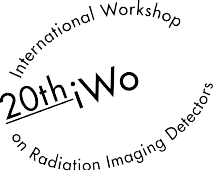Speaker
Description
This presentation demonstrates a method for the simulation of particle tracks in Timepix hybrid pixel detectors using Geant4.
NASA uses Timepix hybrid pixel detectors for several applications including measurement of radiation on the International Space Station and the Orion Spacecraft. An important goal of these measurements is the development of algorithms for particle charge and energy ID. An important tool for this development is software that can produce accurate simulations of detector response for particles of arbitrary charge, energy, and incidence angle. To do this we use a Geant4 Monte Carlo simulation coupled with a model of the detector response.
The typical approach to this problem seen in the literature is to use a Monte Carlo simulation coupled with a drift/diffusion charge transport model and some simulation of detector characteristics such as pixel noise and threshold effects. These methods work extremely well for particles with low stopping power such as protons, often producing results that are excellent matches for experimental data. However they do not accurately reproduce the shapes of tracks for heavy ions. These tracks feature a characteristic ‘core’ region corresponding to the primary track with far more charge sharing than would be expected from drift/diffusion and an extensive `skirt’ region from charge induction effects.
Our approach uses a semi-empirical charge sharing model based on a large database of beam measurements with Timepix sensors. Simple models are developed for both the charge sharing in the core and induction of the skirt. The free parameters in these models are then minimized against experimental data for several different datasets. It is shown that these parameters are largely governed by the particle stopping power. The volcano effect (a saturation effect caused by the behavior of the Timepix front end) can also be simulated resulting in accurate predictions of stopping power for a variety of heavy ions.
This approach differs considerably from a first principles approach in that the model is specifically tuned to 500 μm silicon Timepix detectors. However, it allows rapid simulation speed and accurate reproduction of clusters for all tested species. Particular emphasis is placed on the computational reproduction of experimental observable quantities such as the stopping power, delta electron distributions and reproduction of the volcano effect.
